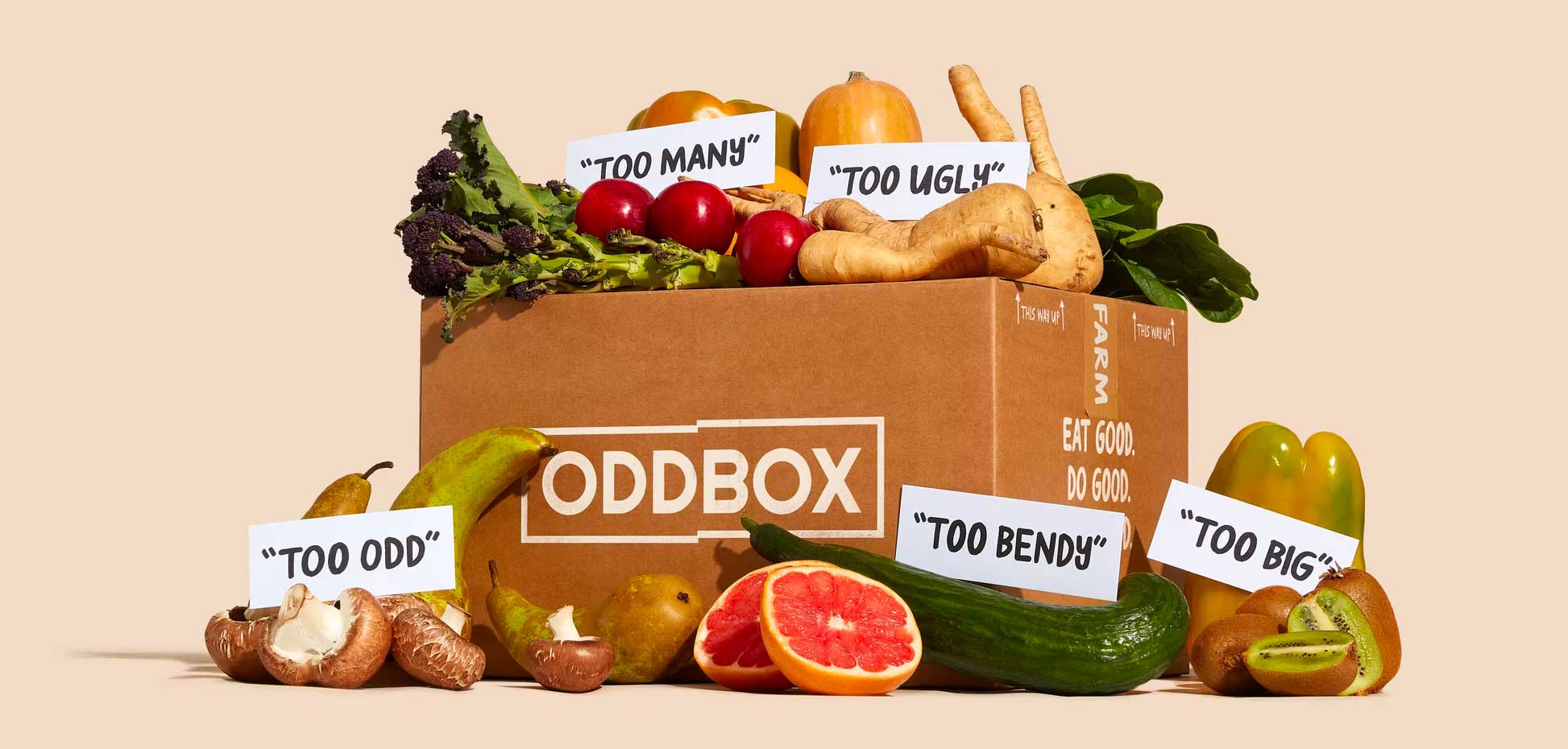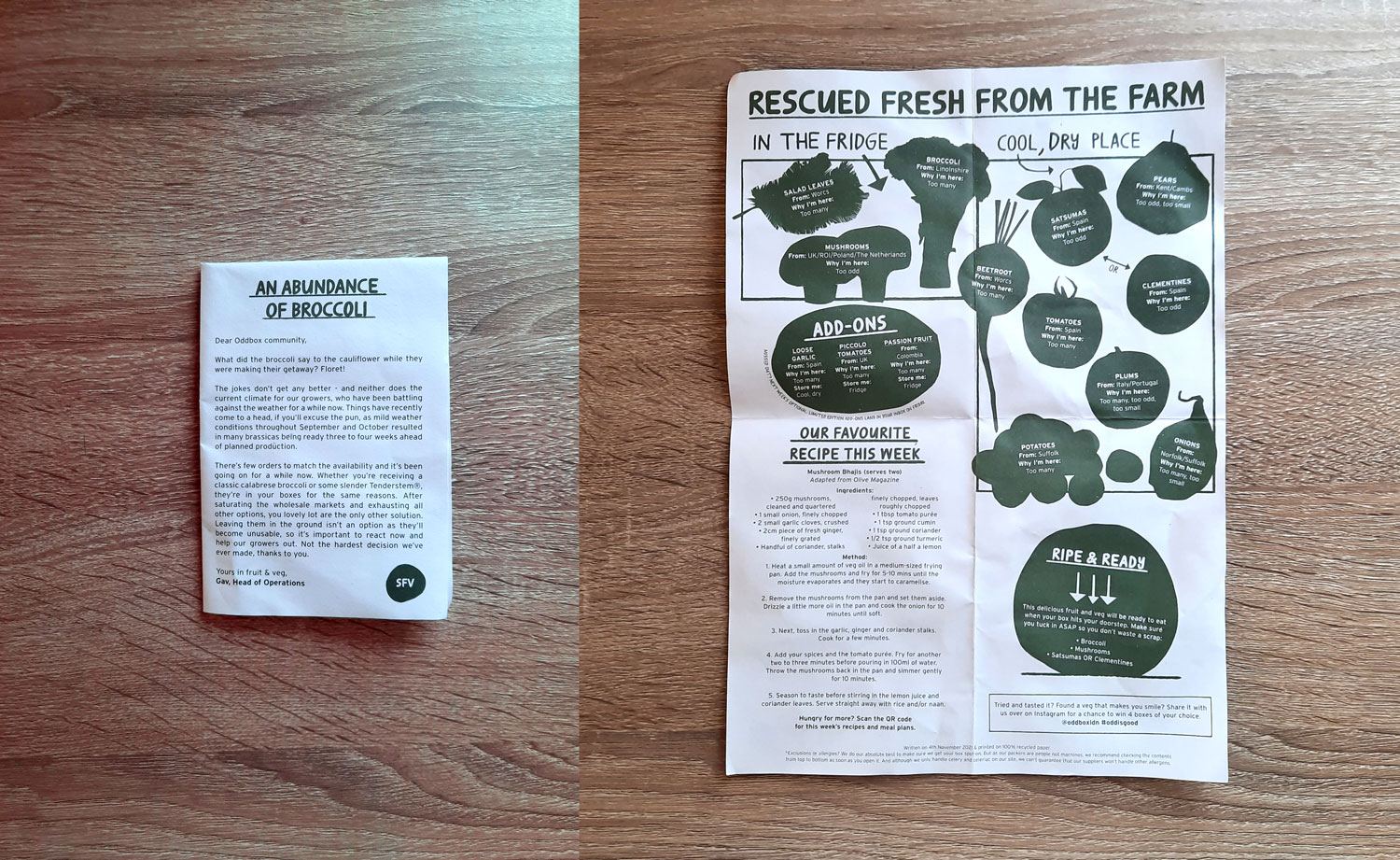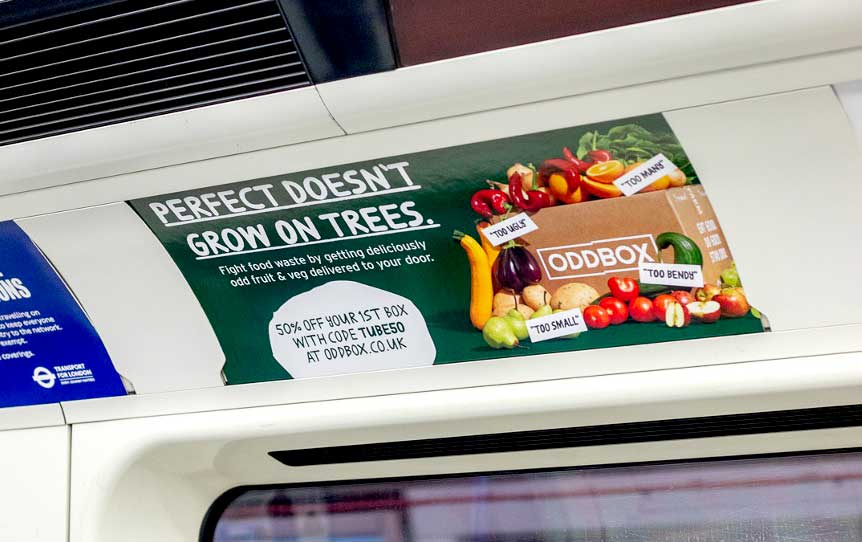The brand manager putting action into words
Ana Caeiro heads up brand comms at Oddbox, the company putting food that’s at risk of going to waste into weekly fruit & veg boxes for people around the UK. We sat down with brand manager Ana to talk about their punchy but playful tone of voice. Or at least, that’s what we thought we were going to talk about. Instead, we got a lesson in what it looks like to be a truly mission-led brand.
Can you tell us a bit about Oddbox?
We’re on a mission to fight food waste. We do that through a community-powered weekly rescue mission that joins farmers to people who want to do good (we don’t call them ‘consumers’). Every week we rescue fruit and veg that has been deemed ‘too odd’ or ‘too many’, and make sure it gets eaten.
We’re interested that you don’t use the term ‘consumers’…
Consumerism can be a source of food waste, and – yes – people have purchasing power, but they are much more than consumers. I supposed this is a tiny example of how the principles of the brand shine through in copy.
Similarly, we’re quite deliberate with how we use quotation marks. We might say a vegetable is “too small” to denote that this is not a term that we subscribe to; this is a term the industry uses.
With these really tiny details, you can inject a lot of meaning into words without having to tell people that those words have meaning.
What brought you to Oddbox?
Since I was about 14, I’ve had this weird obsession with the food industry. In my teens my older sister was a massive idol to me, and she was a vegetarian. She came at it from an animal welfare point of view, but it piqued my interest. So while other kids were playing in school, I was reading books about the food industry. It was very very geeky.
“I needed to align my personal passion with what I do for work.”
I studied Communications in Portugal, which is where I’m from. I did a bit of PR work with the pharmaceutical industry, and learned that I absolutely did not want to work with the pharmaceutical industry. It cemented the idea that I needed to align my personal passion with what I do for work.
I came to the UK to do a Master’s in Public Relations and like everyone – I think it’s kind of a rite of passage here – worked in a pub for a while. It was a sustainable collective of pubs and I started doing digital comms in their head office. Through working with those guys, I got to know the Sustainable Restaurant Association, and got to know about waste, and what a massive problem it is in the food industry.
Then a Brand Marketing position opened up at Oddbox and I was like, ‘This is it.’
Can you tell us a bit about the relationship between the Oddbox mission and brand?
They’re one and the same.
Oddbox started when our founders, Emilie and Deepak, discovered how big of an issue food waste is and decided to do something about it. Fighting food waste is our founding mission and everything we do stems from that mission. That makes the job of branding a little bit easier for us than for brands that try to build in a sustainability story retroactively. It’s a lot more organic.
Beyond those details, the whole Oddbox voice is quite distinctive — cheerful without being cheesy; earnest without being worthy. How did you arrive at your brand tone?
Oddbox’s first employee, Gav Phelps, really embodies the brand. He started writing the letters that go out with our boxes, and the tone of voice emerged quite organically from there.
Then the team grew, our content expanded, and we started to see a tonal divide between different touch points. Some were losing a little bit of the magic and brand personality.
At that point, our former Marketing Director, Mark Paterson, joined. He got us to pause, collect our thoughts, and really question whether we were staying true to our brand personality.
We are by nature a challenger brand, but we were adopting a vanilla tone of voice that wasn’t allowing us to engage people the way we wanted to. We asked ourselves, ‘Isn’t it better to get a reaction from people than no reaction at all?’
So, after many workshops and conversations, we distilled things down to three personality traits, which are: Down-to-Earth, Thoughtful, and Resourceful. Then we have roughly seven to ten copy principles that help us put those traits into practice.
So, for example, within Resourceful, we have a principle we call Make It Count. What that means is, if you’re writing, use just the words you need. Don’t use 20 words when you can say something in five.
“People want to relate to people; people don’t necessarily want to relate to brands.”
Do you think those early origins, with a letter written by one person to another, have helped keep your tone of voice feeling authentic?
I think so. I think you see a lot of formulaic writing in the B2C realm. We try to preserve the feeling that we’re writing as people. Because people want to relate to people; people don’t necessarily want to relate to brands.
Your letters always give specific info on what’s in that box that week. It must be a challenge to make that happen for every delivery?
Because of our sourcing model, we need to know where things are coming from and why we’re rescuing them. Instead of having a contract that tells farmers exactly what to grow and how it needs to look, we have a nurturing relationship with a wide network of growers that are in constant contact with our sourcing team to make up our boxes on a week-by-week basis.
Since we have to pay that sort of attention anyway, it’s natural to pass that info on to the people getting their boxes. It’s still not easy to write different letters according to the fruit and veg in the box, but it makes it personal. And that’s really important to us. It’s a special moment – unboxing – and we try to dramatize it a little bit.
And how do you handle the challenge of communicating a completely new concept?
That’s an interesting question because, definitely when we first cropped up – no pun intended – it was still very new. Plus we have an awareness issue: not a lot of people know food waste is a problem. It’s quite hard to market a solution to a problem people don’t know exists. We still have a lot to do to build mental availability, but we’ve seen good growth so far because we’ve been quite targeted with our marketing efforts.
Years ago, that went as far as post codes where we knew people were already quite savvy when it came to sustainability. That’s helped us scale without breaking the bank. We’ve got the early adopters on board. Now we need to bring later-stage adopters on the journey if we’re going to bring about change.
Getting the message across about food waste must be a challenge, not least because climate change isn’t the cheeriest topic for comms.
It’s something that we consider with every piece of content that we put out, especially when we’re at the heavier end of the topic spectrum. People need to be optimistic in order to act and make change. That’s why we have an overarching brief, which is that every single piece of communication that leaves Oddbox needs to delight, provoke, and empower people.
If we’re just provoking, for example, with a piece of communication about food waste, we’re not delivering on the brief, and it’s not going to be effective – it feels too abstract. If we tell you ‘40% of food goes to waste in the UK’, you probably won’t remember that, but you will remember a story about the asparagus in your box and the farmer who grew it. We use stories to paint a picture of something that can be hard to comprehend otherwise.
Or, if we’re producing recipes, they may feel a bit more light-hearted, but at the end of the day, we’re doing them to help people minimise waste in their kitchens, so it’s quite easy to provoke – to inject the mission into that type of copy in a way that doesn’t feel too heavy or forced.
View this post on Instagram
You have an active following on social media. Is that something you’ve consciously cultivated?
If you met our founders, you’d understand how passionate they are about the people who subscribe to our mission. Because, at the end of the day, if our members didn’t want to rescue from growers, Oddbox wouldn’t exist. We’re just connecting the dots.
So building two-way communication with our community has always been a top priority. It’s easy to overlook that sort of earned media, but it is very powerful and very valuable in helping take your message further. Your community are your biggest brand ambassadors at the end of the day, and you should definitely nurture that. So, from the very beginning, we made sure that if someone writes a comment on one of our stories or posts, we answer it.
That must be quite a job. Who writes all those replies?
Our Customer Happiness Team. We always wanted to make sure that everyone in the business is a custodian of the brand and its tone of voice, not just the Brand Team.
“A tone of voice document is only a guide. At the end of the day, we need to sound like humans.”
You work for such a long time on these tone of voice documents, and it can be daunting to then see them in the wild. But a tone of voice document is only a guide. At the end of the day, we need to sound like humans. We train the Customer Happiness Team on the tone of voice, and they crack on with it.
How did the pandemic affect Oddbox?
We were in a good position to step in when growers needed us the most, because you can imagine how quickly things shifted for people who had contracts in place. When restaurants and food businesses started to close, there was a huge amount of fruit and veg with no place to go.
At the same time, you had a lot of people self-isolating at home who needed food deliveries. So it was a really good opportunity for us to step in and be the vehicle for getting food that was at risk of going to waste to people who needed to eat it. We were able to grow in a way that maximised our impact.
Our content pivoted too. From a household perspective, we saw a massive shift in perception, and a decrease in the amount of food we were wasting as a nation. During lockdown, people were actively looking to reduce waste, because they didn’t know when they would be able to leave the house next. So we started doing more content for people experimenting with food, helping them maximise ingredients and minimise waste. Some of the things we did were so successful that we’re still doing them. The recipes, for example, are now a favourite with our community.
What’s next for Oddbox? Any plans to expand overseas?
I’d say we still have a lot of work to do in the UK. People don’t know the scale of the issue, but, more importantly, people don’t know that food waste is a climate issue. WRAP ran a survey last year, and around 32% of the UK population saw the link between food waste and climate change.
So I’d say 2022 will be the year we try to break into culture, and start a discussion about food waste.
Ana Loves
The Third Plate by Dan Barber, who you might know from Chef’s Table S01 Netflix
Eating the Big Fish by Adam Morgan
Feedback, a food system campaign group doing incredible work
Anything by Jeff VanderMeer
Olafur Eliasson’s unpretentious approach to contemporary art
Dark almond sea salt 51% Tony’s Chocolonely for incredible chocolate (and a top-class example of a challenger brand)
Mala by Devendra Banhart, which got me through the bleak winter lockdown
Peggy Gou when I’m working to a deadline
Love this? Get more.




